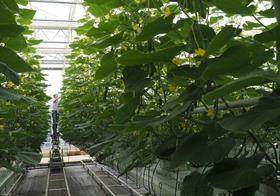
The development of a new low-carbon production system for controlled environment agriculture is underway, following the launch of the RIPEHouse project.
Using greenhouses with windows made of ethylene tetrafluoroethylene (ETFE) rather than glass, the multi-faceted project is aiming to harness the benefits of ‘natural light growing’ alongside bespoke biostimulants, to help optimise the nutrition, flavour and sustainability credentials of fresh produce.
The film being trialled is thesame plastic used for the domes of the Eden Project in Cornwall.
Funded by Defra and UKRI, the work is being conducted by a consortium consisting ofCrop Health & Protection (CHAP),RIPE Building Services,the University of Warwick,Evoponic,Mudwalls Farm andValefresco.
Innovation network lead for CHAP, Dr Harry Langford, said: “Unlike glass, ethylene tetrafluoroethylene (ETFE) filmtransmits full spectrum sunlight into the growing area. The benefits of this are starting to be explored at CHAP’s Natural Light Growing Centre, a structure clad in ETFE.
“The RIPEHouse project plans to take this one step further, by combining natural light growing with the use of bespoke biostimulant products. This will enable UK growers to deliver high quality, lower carbon produce compared to that of traditional glasshouse systems.
“Once completed, this could mean a real step-change for the way in which we grow fresh produce in the UK.”
The RIPEHouse project aims to develop and validate the natural light growing system to enable two cycles of production per year for crops such asbaby cucumbers. While doing so, it hopes to demonstrate carbon-efficient conditions through comparative trials, versus conventional glasshouse production.
Finally, the project will investigate market-disruptive business models such as local food hubs and meal boxes, to respond to consumer demand for healthier diets and British-grown produce.
Founder and managing director of RIPE, Phillip Lee, said: “Independent testing by Campden BRI has already shown that baby cucumbers grown within the Natural Light Growing Centre rank higher for taste and eating enjoyment compared to those grown in conventional systems.
“This has provided valuable evidence required to support the ethos behind the centre and the use of ETFE in commercial production.
“Furthering this byusing biostimulants will enable us to explore how we can improve the resilience and health status of the plants, potentially extending the production season and reducing the reliance on traditional pesticidal products.”
Biostimulants arenatural products used to stimulate plant processes such as nutrient uptake, nutrient use efficiency, and protection against abiotic stress. In doing so, this maintains plant health, as the best protection against pest and disease pressure and further plant stresses.
This could also reduce the use of fossil fuels for heating and CO2 enrichment within a controlled environment agriculture setting.
Joe Pilade, company director at Valefresco, said: “Efficient and sustainable low-carbon production would mean growers are in a stronger position to meet supply chain demands and reduce imports.
“Meanwhile, consumer demand for creative culinary solutions is increasing, through the likes of local food hubs and meal boxes. This project coordinates many facets of sustainable production from nurturing the seed through to marketing the harvested produce.
“We are delighted to be working on this transformative project, which is all thanks to a successful Defra-UKRIFarming Innovation Pathways (FIP) industrial research competition submission.”
Meanwhile, Mudwalls MD George Beach said he was delighted to support the project by introducing baby cucumbers grown using the method to retailers such asMindful Chef,44 FoodsandMidCounties Coop.
“We look forward to lots more products being grown under this regime,” he added.
The project work will take place at the Natural Light Growing Centre, based at the University of Warwick’s Wellesbourne Campus.



